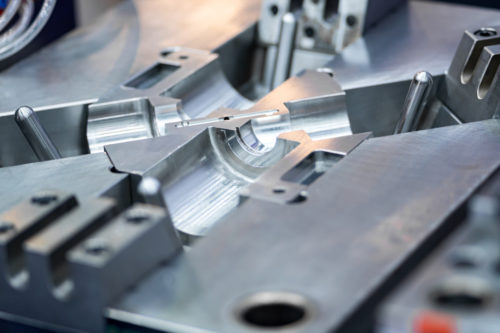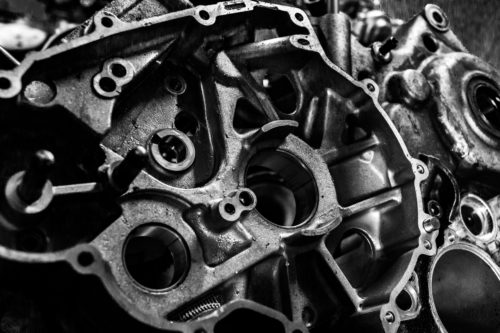Top Four Common Defects in High-Pressure Die Casting Process
A Quick Look at the High-Pressure Die Casting Process
Die casting is a cost-effective method for manufacturing high-fidelity metal pieces in medium to high volumes. It can produce complex components to tight tolerances with excellent surface finishes when it is performed correctly. However, many issues may arise during production operations that can affect the quality of the cast parts and products.
The high-pressure die casting process involves injecting molten metal under high pressure into a pre-fabricated steel die or mold. High speed-injection ensures that the liquid material is forced into every section of the die cavity. The result is highly accurate components with exceptional details and smooth finishes once the material is allowed to cool and harden.
Top Four Common High-Pressure Die Casting Defects
Zinc and aluminum high-pressure die casting processes rely on highly accurate and precise metal temperatures, mold temperatures, gas ventilation, and injection pressure. The cast component can also be air or water-cooled, depending on the material. If the temperature, cooling method, or injection pressure are not correct, a number of die cast defects can occur.
The four most common defects found in components made using the high-pressure die casting process are porosity, blisters, cold shuts, and misruns.
1. Porosity
Porosity refers to holes or voids in solid cast metal components, and is one of the most common defects of die casting. They can range from very small (microscopic) to very large (several cubic millimeters or larger). The two main causes of porosity are solidification shrinkage and gas porosity.
- Solidification shrinkage occurs when the molten metal cools too quickly after being injected into the mold. The metal shrinks as it solidifies against the cooler mold wall, creating pores in the still-liquid metal away from the wall.
- Gas porosity refers to pockets formed by air or gas trapped in the mold. It can occur due to many conditions, including insufficient venting or material mixing during the mold filling stage.
Manufacturers can correct these issues by modifying the mold design and/or casting operation to ensure even cooling, reduce shrinkage, or decrease the risk of entrained air. The right solution depends on the root cause of porosity.
2. Blisters
Blisters are a form of gas porosity that occurs closer to the surface of the component, often appearing as visible raised bubbles after the die-casting process. They are formed when high-pressure air or gas trapped within the casting pushes the material outward after it is removed from the mold.
The solutions for blisters are based on the same principle as the solutions for internal gas porosity: reduce entrained air. They may involve cooling the mold at a different rate, adjusting water flow, increasing cooling time, or quenching the component upon ejection from the mold. You can also change the temperature of the alloy to reduce the thermal difference between the mold and the metal.
3. Cold Shuts
Cold shuts—also known as cold laps—occur when metal molten flows into the mold via two or more channels but cools too quickly. As a result, the streams solidify before meeting, which prevents them from forming a seamless piece.
This die casting defect typically occurs because of poor gating system design or lack of material fluidity. Manufacturers can prevent it by modifying the gating system, increasing pour temperatures, or improving the mold’s gas permeability.
4. Misruns
Misruns occur in similar conditions to cold shuts. However, the molten metal cools so quickly that it does not completely fill the mold, resulting in incomplete components.
The solutions for misruns are similar to the solutions for cold shuts. Manufacturers should check the mold design, the gating system design, and/or the fluidity of the molten metal.
High-Pressure Die Casting Solutions at DyCast Specialties
Manufacturers may encounter a variety of issues during the high-pressure die casting process. Knowing why they occur and how to avoid them is an indicator of a good die casting partner.
At DyCast Specialties Corporation, we provide high-pressure die casting solutions to customers in a broad range of industries. Our experts carefully set up and conduct operations to avoid metal casting defects in components. To learn more about our die casting services, contact us or request a quote today.
Aluminum Die Castings for the Communications Sector
What is Aluminum Die Casting?
Aluminum die casting is a manufacturing process used to create smooth, precise, defined, and textured metal components. The alloys used with aluminum die casting offer many benefits such as high thermal and electrical conductivity, corrosion resistance, good mechanical properties, high dimensional stability, and low weight. These desirable properties make aluminum die castings an excellent option for various applications within the communications sector.
Applications of Aluminum Die Castings for the Communication Sector

Other applications for aluminum die cast parts throughout the communications industry include:
- P.C. accessories and hardware. Computer hardware and various accessories rely on die cast parts due to their heat dissipating properties.
- Relay boards. Aluminum die cast parts are utilized because they are lightweight and can withstand heat from the device’s operating system.
- Hubs. Aluminum die cast parts are extremely durable and lightweight, making them a great option for hubs.
- Communication equipment. Communication equipment is often made with aluminum die cast parts due to their strength, excellent dimensional stability, corrosion resistance, and heat dissipating properties.
- Set top box systems. Aluminum die cast components are a strong, cost-effective material choice for set top box systems.
- Electrical housings. Aluminum die cast parts feature good shielding properties and electrical performance, making them a great option for electrical housings.
- Electronic connectors. Aluminum is a natural conductor, making aluminum die casts ideal for electronic connectors.
- Antenna mounts. Antenna mounts can benefit from these components due to their durability, low weight, and high conductivity.
- RF filters. Aluminum is widely used in RF filters due to its effective shielding properties.
- Front face plate. Aluminum die castings are lightweight and durable, making them ideal for front face plates.
Advanced Aluminum Die Casting at DyCast Specialties
Many companies in the communications sector and other industries choose to partner with DyCast Specialties to meet their aluminum die casting needs. We offer high-quality aluminum die casting services for a wide range of industries and applications. Our trained and highly equipped team can manage the entire aluminum die casting process from the project’s initial design to the machining, finishing, and final shipment.
We work with various aluminum alloys, including 380, 383, and 413, to produce lightweight and intricate die castings for many applications. Our facility is equipped with in-house CNC machining centers with tolerance capabilities within +/- 0.00025 of an inch. Depending on your specific needs, we can provide additional processes including coating, annealing, testing, inspecting, and assembling of your products.
Please contact us today to see how your organization can benefit from our quality aluminum die casting services, or request a quote to get started. With DyCast Specialties, you can count on us to produce parts made to your exact specifications, with superior customer service throughout the entire process.


